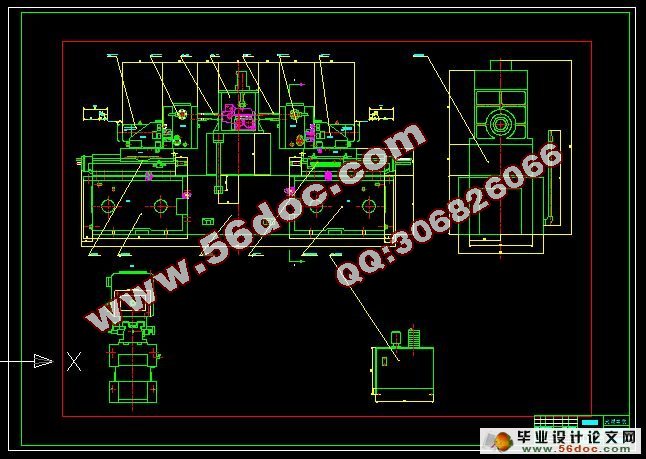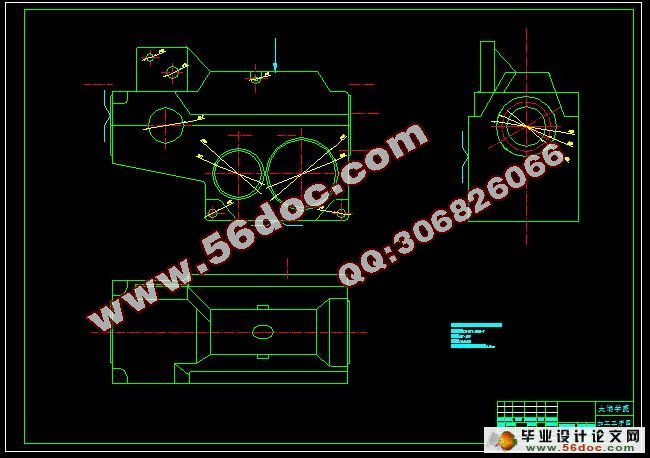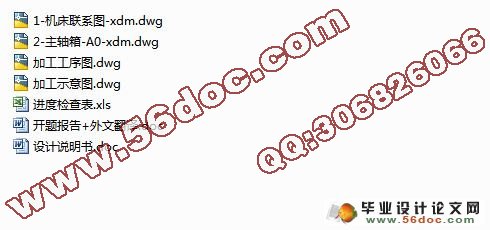梳棉机箱体结合件钻孔专机设计
无需注册登录,支付后按照提示操作即可获取该资料.
梳棉机箱体结合件钻孔专机设计(任务书,开题报告,外文翻译,进度计划表,论文说明书16000字,cad图纸4张)
摘 要
组合机床是以通用部件为基础,配以按工件特定形状和加工工艺设计的专用部件和夹具,组成的半自动或自动专用机床。它一般采用多轴、多刀、多工序、多面或多工位同时加工的方式,生产效率比通用机床高几倍至几十倍。由于通用部件已经标准化和系列化,可根据需要灵活配置,能缩短设计和制造周期。因此,组合机床兼有低成本和高效率的优点,在大批、大量生产中得到广泛应用,并可用以组成自动生产线。[1]本文从五个方面即梳棉机箱体结合件的加工工艺、组合钻孔工序的夹具设计、液压控制系统设计和液压元器件的选择、组合机床设计对梳棉机箱体结合件的制造做了详细的阐述,简要说明了现代制造工艺和制造设备与梳棉机的关系。
通过对生产批量的分析来确定梳棉机箱体结合件的加工方案,同时找出最佳的工艺方案;在组合钻孔工序的工装设计过程中,通过实际,根据夹具设计原则与设计方法取得夹具设计的最优化方案;对孔的加工精度做了深入研究,优化了加工工艺路线;在设计液压控制系统的过程中,将双面钻孔组合机床作为对象,根据液压系统设计的基本原理,制定出合理的液压系统图。液压元件的规格依据对系统主要参数的计算从而确定;在设计组合机床的过程中,通过具体实例和设计经验, 说明了通用件(如液压滑台,动力箱等)的选取及专用部件(如主轴箱)的设计计算。
关键词:组合机床;多轴箱;钻夹具
Abstract
The combination of the commonand the components machine is based on specially designed components fixtures together with the specific shape of the work piece and process design, consisting of semi-automatic or automatic special purpose machine. It is commonly used multi-axis, multi-tool, multi-process, multi-faceted or multi-station processing at the same time, the production efficiency several times or more higher than the general machine. Common components have been standardized and serialized, can be flexibly configured, can shorten the design and manufacturing cycle. Therefore, the combination machine combines the advantages of low cost and high efficiency, has been widely used in a large number of mass production, and can be used to form an automatic production line. This article from the five aspects combined with the process of the carding machine cabinet, the combination fixture design of the drilling process, hydraulic control system design and hydraulic components selection, a combination of machine tool design carding machine cabinet combination of manufacturing done in detail exposition, a brief description of the relationship of the modern manufacturing process and manufacturing equipment carding machine.
Analysis of the production volume to determine the carding machine cabinet combined the parts processing program, at the same time to find the best process; combination drilling process tooling design process through the actual fixture according to the the jig design principles and design methods design optimization programs; hole machining accuracy, optimized processing route; in the design of the hydraulic control system, the double-sided drilling combined machine tool as an object, the basic principle of the hydraulic system design, the development of reasonable hydraulic system diagram. Specifications of hydraulic components based on the calculation of the main parameters of the system in order to determine; through concrete examples and design experience in the design of the modular machine tool, indicating that the selection of common parts (such as hydraulic slide, power boxes, etc.) and specially designed components (such as The spindle box) design calculations.
Key words: combination machine tool; axle boxes; drills clamp





目 录
摘 要 III
ABSTRACT IV
目 录 V
1 绪论 1
1.1 本课题的研究内容和意义 1
1.2 国内外的发展概况 1
1.3 本课题应达到的要求 1
2 工艺方案的拟定 2
2.1 梳棉机箱体结合件零件的工艺技术分析 2
2.1.1 面 2
2.1.2 孔 2
2.2 定位分析、基准选取及制定工艺路线 3
2.2.1 粗基准的选择 3
2.3 选择精基准 3
2.2.3 重要工序分析 4
2.2.4 工艺路线 4
3 钻夹具设计 6
3.1 梳棉机箱体结合件钻孔专机夹具分析 6
3.1.2 基本定位原理分析 6
3.1.3 夹紧力“三要素”,方向,作用点,大小 6
3.2 定位夹紧方案的确定 6
3.3 刀具选择及切削用量的选取 7
3.3.1 技术分析 7
3.3.2 刀具选择 7
3.3.3 切削用量的选取 7
3.3.4 工作行程的确定和钻模板的设计 7
3.3.5 主轴尺寸类型及接杆选择 8
3.4 夹具体设计 8
4 组合机床总体设计 12
4.1 被加工零件工序图 12
4.1.1 被加工零件工序图的作用与内容 12
4.1.2 绘制被加工零件图的规定及注意事项 12
4.2 加工示意图 13
4.2.1 加工示意图的作用和内容 13
4.2.2 选择刀具、导向及有关计算 13
4.3 机床联系尺寸图 14
4.3.1 机床联系尺寸图作用 14
4.3.2 绘制机床尺寸联系总图之前应确定的内容 14
4.4 机床分组 15
5 液压系统设计 18
5.1 液压压紧系统设计 18
5.1.1 作F-t与V-t图 18
5.1.2 确定液压系统参数 19
5.1.3 拟定液压系统图 19
5.2 钻削进给液压系统设计 19
5.2.1 作F-t与V-t图 19
5.2.2 确定液压系统参数 21
5.2.3 拟定液压系统图 21
5.2.4 选择液压元件 22
6 多轴箱——右主轴箱设计 24
6.1 绘制多轴箱设计原始依据图 24
6.1.1 主轴、齿轮的确定及动力运算 25
6.1.2 多轴箱传动设计 27
7 技术经济性分析 32
7.1 加工工艺的制定 32
7.2 夹具定位的加紧 32
7.3 组合机床的应用 32
8 结论和展望 33
8.1 结论 33
8.2展望 33
致 谢 34
参考文献 35
